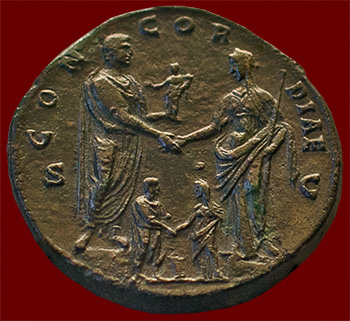
Marital Concordia, Sestertius of Antoninus Pius, c. 140 CE

Harmony (concordia) was an ideal for the Romans, who personified this not so abstract quality as a goddess and sought to realize it in three core areas of their lives: the military (concordia militum), the civic (concordia ordinum), and the domestic (concordia familias). In the category of religio, they promoted concordia though a related goddess, Pax, who presided over the vital compact of the Roman State with the gods (pax deorum). Despite their pursuit of this philosophical concept, physical violence outside of war, such as rape, beatings, robbery and murder, against women of all classes, was commonplace, frequently within the Roman family. While domestic abuse was only sporadically reported, there is evidence of it -- beyond the master-slave relationship -- throughout the Roman Empire in stories about imperial women (Octavia, Poppaea, Regilla) as well as non-elite women (Monica, Petronius' Fortunata). Unless the woman and her family (natal or marital) were wealthy and had fairly high social rank, sorrowing survivors would find it difficult to seek justice against domestic violence. There was no police force as we know it or public arrest of suspects and imprisonment until trial. Unlike our modern criminal justice system, which treats murder as a crime against the state, it was up to family members to hire a prosecuting lawyer at their own expense and to provide evidence and witnesses, or to seek revenge.
The two inscriptions below give evidence of unhappy marriages that resulted in uxoricide, despite the easy option for men of divorce (divortium), where a husband needed only leave his wife and return her dowry, if there was one, to dissolve their marriage. Nevertheless, during the Empire even a woman's high birth, wealth and fame did not deter domestic violence, as in the case of Appia Annia Regilla Atilia Caucidia Tertulla, priestess and civic benefactor of Olympia. Related to several emperors and empresses through her maternal and paternal family lines, she was married at the age of 14 in 139 CE to Herodes Atticus, the prominent, rich Greek aristocrat, philosopher, and Roman senator, who was appointed as Greek tutor to young Marcus Aurelius. After their departure to Greece in 160 CE, Regilla miscarried and died, allegedly kicked in the abdomen while pregnant by one of her husband's freedmen, Alcimedon. Though Regilla's brother, Appius Annius Atilius Bradua, brought charges in Rome against Herodes Atticus, Emperor Marcus Aurelius declared him innocent; not only did Herodes Atticus never punish Alcimedon, but he kept him in his service (for more information on Regilla's death, see Pomeroy's book in the Bibliography).
Prima Florentia was unfortunate in her marriage to a man who ultimately murdered her (see the tablet inscription, which is discussed by Mary Beard in "Meet the Romans" part 3). Given her age, she could not have been married long. Her parents, Restutus Piscinensis and Prima Restuta, who commissioned her funerary plaque, and her relative, December, who set up her memorial, were probably not successful in prosecuting her husband, as her epitaph makes no mention of his punishment. Instead, her family resorted to condemnation by public opinion, publishing his infamous act and naming him on the tablet as her murderer for all to see. Although it seems safe to say that the family came from the lower classes, because their names do not fit into the conventional Roman naming patterns, they do not give clear evidence of their social status: Florentia and her parents are recorded with two names each, while her kinsman December and her husband Orfeus are simply referred to by their cognomen and their relationship to her. Second century CE. Portus, Italy.
ET PRIMA RESTUTA PRIMAE
FLORENTIAE FILIAE CARISSIMAE
FECERUNT QU{I}[ae] AB ORFEU MARIT{U}[o] IN
5 TIBERI DECEPTA EST. DECEMBER COGNATU[s]
Julia Maiana's epitaph memorializes her as the mother of two children, a boy and a girl, and the long-standing wife of a husband who murdered her. What caused this violent end to a twenty-eight year marriage will never be known, nor how long during the marriage Julia Maiana suffered conjugal violence. To judge from the adjectives sanctissimae and crudelissimi and the apostrophes to the deae Fides and Pietas, her dedicators, her brother and son, sided with Julia Maiana. Referred to only as maritus crudelisimus, her husband's name is not recorded, perhaps because he and his behavior were well-known in the community (see Augustine's passage about the marriage of his mother Monica), or perhaps to consign him to oblivion in an act of damnatio memoriae. While the letters of the inscription are elegantly carved, the text is complicated by abbreviations, misspellings, and damage to the face of the monument. The dedication D M, commonly found at the head of funerary inscriptions over the first three centuries of the Empire, is separated here by two examples of a symbol that appears only on funerary monuments from the Roman province of Gallia Lugdunensis, the capital of which was modern-day Lyon (Lugdunum). The symbols are an icon of a mason's hammer that represents the phrase sub Ascia (found abbreviated at the end of this inscription). 326 CE. Lyon, France.
ET QVIETI AETERNAE
IVLIAE MAIANAE, FEMI-
5 MARITI CRVDELISSIM[i] INTER-
FECT[ae], QVAE ANTE OBI[i]T QVAM FAT[u]M
DEDIT; CVM QVO VIX[it] ANN[os] XXVIII, EX
QVO LIBER[os] PROCREAV[it] DVOS, PVER[u]M
ANN[orum] XVIIII, PVELLAM ANNOR[um] XVIII.
10O FIDES! O PIETAS! IVL[ius] MAIOR, FRA-
TER SORORI DVLCISS[imae], E[t Inge]NVINIVS
Click on the underlined words for translation aids and commentary, which will appear in a small window. Click on the icon link
![]() to the right of the text for related images and information.
to the right of the text for related images and information.